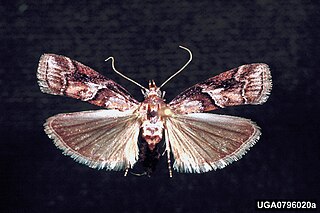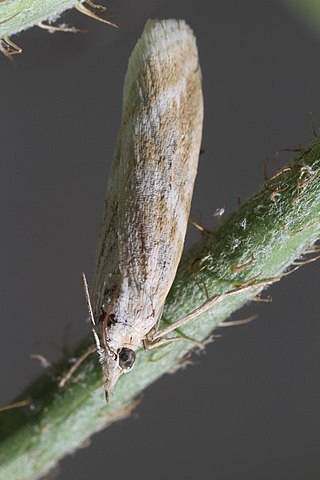
The Tortricidae are a family of moths, commonly known as tortrix moths or leafroller moths, in the order Lepidoptera. This large family has over 11,000 species described, and is the sole member of the superfamily Tortricoidea, although the genus Heliocosma is sometimes placed within this superfamily. Many of these are economically important pests. Olethreutidae is a junior synonym. The typical resting posture is with the wings folded back, producing a rather rounded profile.

The Pyralidae, commonly called pyralid moths, snout moths or grass moths, are a family of Lepidoptera in the ditrysian superfamily Pyraloidea. In many classifications, the grass moths (Crambidae) are included in the Pyralidae as a subfamily, making the combined group one of the largest families in the Lepidoptera. The latest review by Eugene G. Munroe and Maria Alma Solis retain the Crambidae as a full family of Pyraloidea.

Dioryctria abietella is a moth of the family Pyralidae. It is found in Europe.

Dioryctria sylvestrella, the new pine knot-horn or maritime pine borer, is a moth of the family Pyralidae. It is found in Europe, parts of Asia and North Africa. The adult is a small mottled brown and white insect with a wingspan of 28 to 35 mm. The moth flies in a single generation from June to October and is a pest of maritime pine and several other species of pine, on which the caterpillars feed.

Sciota subcaesiella, the locust leafroller moth, is a species of moth of the family Pyralidae. It is found in North America, including Maryland, New Jersey, Oklahoma, Iowa, North Carolina, South Carolina, Georgia, Alabama, Mississippi, Maine, New Hampshire, New York, Massachusetts, Pennsylvania, the District of Columbia, Virginia, Tennessee, Illinois, Missouri, Arkansas, Nova Scotia and Ontario.

Dioryctria zimmermani, the Zimmerman pine moth, is a moth of the family Pyralidae. It is found from southern Canada and the north-eastern and Great Lakes areas of the United States. There is a disjunct population in eastern Nebraska.

Dioryctria clarioralis, the blister coneworm moth, is a moth of the family Pyralidae. It is found in the eastern United States, including Florida, New Jersey and Virginia.

Pococera robustella, the pine webworm moth, is a species of moth of the family Pyralidae. It is found in southern Canada and the eastern United States from Minnesota to New England and south to Florida.

Dioryctria is a genus of snout moths. It was described by Philipp Christoph Zeller in 1846.

Dioryctria albovittella, the pinyon tip moth, is a species of moth of the family Pyralidae. It is found in North America including New Mexico.

Dioryctria auranticella, the ponderosa pineconeworm moth, is a moth of the family Pyralidae. The species was first described by Augustus Radcliffe Grote in 1883. It is found in western North America from southern British Columbia south to California and Arizona, east to South Dakota and New Mexico.

Dioryctria ponderosae, the ponderosa twig moth, is a moth of the family Pyralidae. The species was first described by Harrison Gray Dyar Jr. in 1914. It is found in North America from Washington and Montana south to California and northern Mexico.

Dioryctria resinosella, the red pine shoot moth, is a species of moth of the family Pyralidae described by Akira Mutuura in 1982. It is found in Ontario and the northern United States.

Dioryctria ebeli, the south coastal coneworm moth, is a species of moth of the family Pyralidae. It is found in the US states of Florida, the southern parts of South Carolina, Georgia, Alabama, Massachusetts, and south-eastern Louisiana.

Dioryctria amatella, the southern pineconeworm moth, is a species of moth of the family Pyralidae. It is found in the south-eastern United States, from Maryland south to Florida and west into Texas.

Bradyrrhoa gilveolella is a species of moth of the family Pyralidae. It was described by Georg Friedrich Treitschke in 1833. It is found in Greece, Sicily, Albania, North Macedonia, Bulgaria, Romania, Turkey, southern Russia, from Kazakhstan to Ukraine and south to central Iran.

Dioryctria reniculelloides, the spruce coneworm, is a moth of the family Pyralidae. The species was first described by Akira Mutuura and Eugene G. Munroe in 1973. It is found from Nova Scotia to Alaska, south in the east to New York, and south in the west to California and New Mexico. It was recorded from China in 2009. Occasionally abundant, often in conjunction with epidemics of the spruce budworm, the spruce coneworm occurs through most or all of the range of spruce in North America, feeding on new foliage and cones of spruce, and often balsam fir. When abundant, it can be a serious pest "particularly on white spruce".
Dioryctria rubella, the pine shoot moth, is a species of snout moth in the genus Dioryctria. It was described by George Hampson in 1891 and is known from south-east Asia, including China and the Philippines.
Dioryctria taedae is a species of snout moth. It was described by Schaber and Wood in 1971, and is known from Maryland to the south-eastern United States.
Dioryctria taedivorella, the lesser loblolly pineconeworm moth, is a species of snout moth in the genus Dioryctria. It was described by Herbert H. Neunzig and Nancy Antoine Leidy in 1989, and is known from North America, where it is found from eastern Virginia and North Carolina to northern Alabama and Mississippi.






















